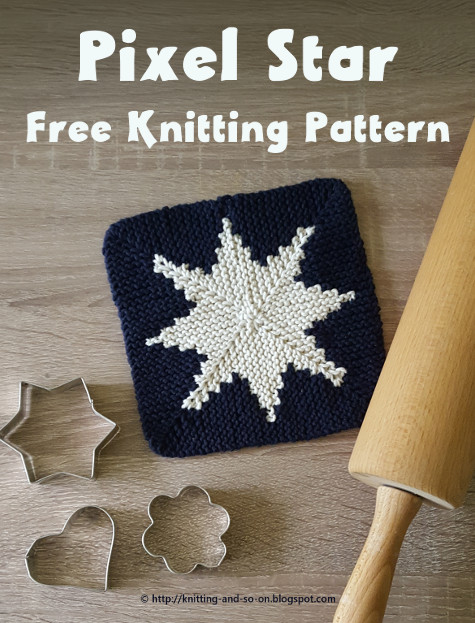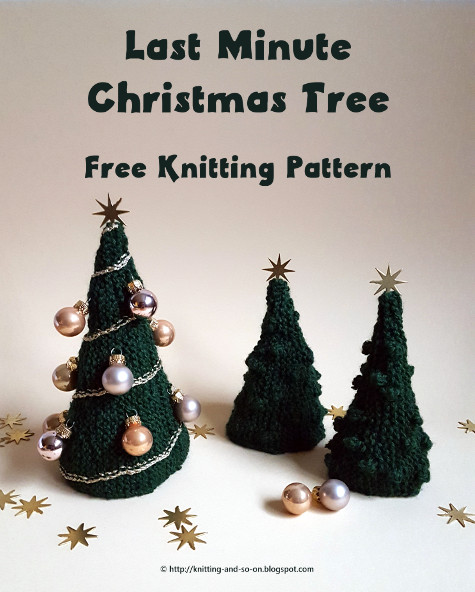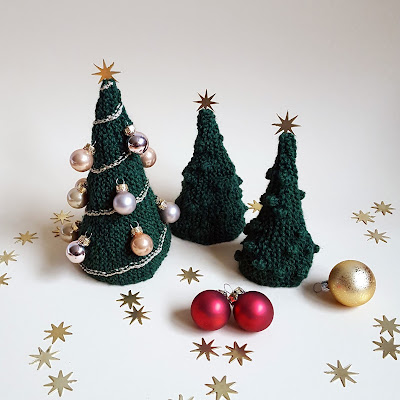I love knitting small seasonal and decorative pieces - especially for Easter and Christmas. This time I wanted to knit little easter bunnies to add a touch of cuteness to the Easter egg nests. I used a construction in the round and in stockinette stitch - knitted from the bottom up.
The finished bunnies are about 15 cm high - they are great to use up yarn leftovers.
Please note, this is fiddly work - esprecially the cast on, the first few rounds, and the finishing. But I really like the result.

This work by
Knitting and so on is licensed under a
Creative Commons Attribution-NonCommercial-NoDerivatives 4.0 International License.
 Materials
Materials
- light colored leftover yarn - I guess I used less than 10 grams of fingering weight yarn
- 2.5mm knitting needles - I used Addi Trios, but you can also use dpns or circulars (magic loop method)
- black embroidery floss or black fingering weight yarn to stitch on the face
- an embroidery needle
- stuffing - I used yarn leftovers and to give them some stability I even put a couple of pebbles right into the bottom of the lower half of their body
Techniques
- Shadow Wrap Short Rows - used throughout the pattern: as shown in this YouTube video by Lee Meredith. A video by Miriam Felton that shows how to do a heel with shadow wraps can be found here on YouTube. However, the heel knitted here is knitted slightly different because here there are two rounds between the two parts of the heel, i.e. there won't be any triple stitches.
- Knitting the Shadow Wraps: In a knit row (i.e. you're knitting on the outside of your socks), you knit up to the stitch where you want to turn, and then knit into the stitch in the row below, i.e. you insert the right hand needle from the front into the stitch below the next stitch and pull your working yarn through. Then you put the loop onto the left hand needle (creating a double stitch from the stitch below) - keeping the yarn on the back. Then you turn and your yarn is now in front, tighten it to make sure that all stitches have the same size and start to purl in the opposite direction. This sequence (knitting int the stitch below and turning) will be called kbelow in the pattern.
If you're in a purl row, you purl into the stitch of the row below, i.e. insert the right hand needle from the back into the stitch below and draw your yarn through and put the stitch onto your left hand needle - creating a double stitch. The yarn is in front while you're doing this. Turn your work. The yarn is now on the back of your knitting. Make sure that the stitch is as tight as the other stitches on your needles and start knitting in the opposite direction. This sequence will be called pbelow in the pattern.
- Knitting the double stitch.: When you come to a double stitch you can simply knit / purl it as one. This looks well when you're working it in the same direction it was created (i.e. the double stitch was created in a purl row and is also worked in a purl row). However, when you have to knit a double stitch that was created in a purl row, the following sequence made the result look a bit neater. I slipped the first loop of the double stitch to the right hand needle, turned the second loop so that the front leg was now in the back and put the first loop back facing the same way (i.e. the former front leg was now in the back). Then I knitted both loops through the back loop.
Instructions
Body
CO 8 sts an join in round
Round 1: k all
Round 2: * kfb repeat from * to end (16 sts)
Round 3: k all
Round 4: * k1, kfb repeat from * to end (24 sts)
Round 5: k all
Round 6: * kfb, k2 repeat from * to end (32 sts)
Round 7: k all
Round 8: * k2, kfb, k1 repeat from * to end (40 sts)
Rounds 9-10: k all
Round 11: * k1, kfb, k3 repeat from * to end (48 sts)
Round 12: k10, kfb, kfb, kfb, kfb, kblelow, p8, pbelow, k to end (the little bulge that will be created during the next rounds will be the tail - it's on the first half of the round)
Round 13: k18, kbelow, p8, pbelow,, k7, kbelow, p6, pbelow, k to end
Round 14: k10, ssk, ssk, k2tog, k2tog, k to end (your total stitch count is back to 48 sts)
Round 15-17: k all
Round 18: * k5, k2tog, k5 repeat from * to end (44 sts)
Round 19: k all
Round 20: * k2tog, k9 repeat from * to end (40 sts)
Round 21: k all
Round 22: * k2, k2tog, k6 repeat from * to end (36 sts)
Round 23: k all
Round 24: * k7, k2tog, repeat from * to end (32 sts)
Round 25: k all
Round 26: * k2, k2tog repeat from * to end (24 sts)
Round 27: k all
Start stuffing the lower part of the body
Head
Round 1: * k1, mk1, k2 repeat from * to end (32 sts)
Round 2: k all
Round 3: k16, k5, mk1, k6, mk1, k5 (the bulge that will be created now, is the snout, it's on the 2nd half of the round)
Round 4: k16, k5, kfb, kfb, k4, kfb, kfb, k5
Round 5: k4, mk1, k8, mk1, k4; k4, mk1, k14, mk1, k14
Round 6: k all
Round 7: k18; k4, ssk k12, k2tog k4
Round 8: k18; k5, ssk, ssk, k4, k2tog, k2tog, k5 (2 x 18 sts = 36 sts)
Round 9: k all
Round 10: k3, ssk, k4, k3, ssk, k4; k4, ssk, k6, k2tog, k4 (32 sts)
Round 11: k all
Round 12: * k2tog, k6 repeat from * to end (28 sts)
Round 13: k all
Round 14: * k4, k2tog, k1 repeat from * to end (24 sts)
Round 15: k all
Round 16: * k1, k2tog, k3 * repeat from * to end (20 sts)
I stitched on the face after finishing this. Then I stuffed the head.
However, it is an option to stitch on the face after you finish knitting the rabbit.
Ear 1
You now have 20 sts on your needles. To knit the first ear, you will only need the first 4 sts and the last 4 sts of that round. So:
Round 1: k2tog, k2, put the next 12 sts on two stitch holders (safety pins or scrap yarn), k2, k2tog
Round 2: (only knitting the stitches that are still on your needles): k all
Round 3: kfb, k1, kfb; kbf, k1, kfb (your piece should now look similar to illustration 1)
Round 4-6: k all
Round 7: kbf, k3, kfb, kfb, k3, kfb
Rounds 8-14: k all
Round 15: ssk, k3, k2tog, ssk, k3, k2tog
Round 16-18: k all
Round 19: ssk, k1, k2tog, ssk, k1, k2tog
Round 20: k all
Round 21: sl1, k2tog, psso; sl1, k2tog, psso
BO
 |
| Illustrations |
Ear 2
From the top, your piece should look like illustration 2. The second ear will be knitted over the 8 sts that are furthest away from the first ear, i.e. the stitches that are on the left of illustration 2.
Put 2 x 4 stitch from the stitch holders back on your needles. There will be 2 x 2 sts left over - unknitted and on the stitch holders.
Now knit rounds 1 to 21 of Ear 1 and BO.
Finishing
There are 2x2 unknitted stitches left on your stitch holders. Put these on your needles (see illustration 3).
If you haven't stuffed your bunny yet, now is the last chance to do it.
Connect the 2 rows of 2 stitches using the kitchener stitch.
Weave in ends.
Variations
If you want a bunny that is a bit bigger (like the one on the left on the picture above), you can knit a few more "k all" rounds between round 15-17 of the body.


















































